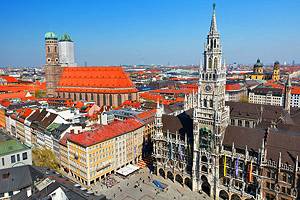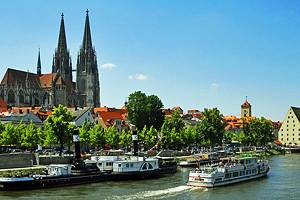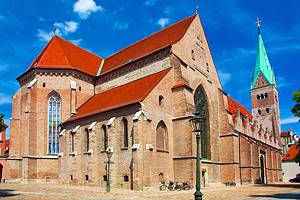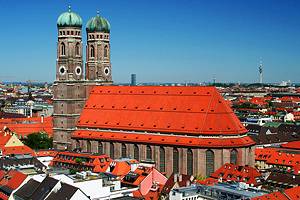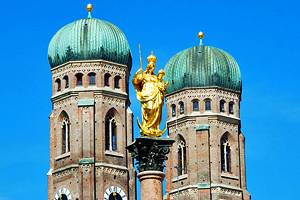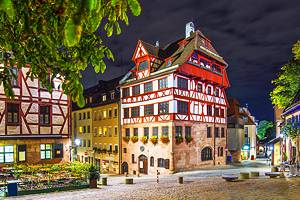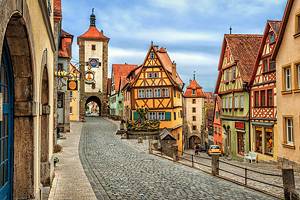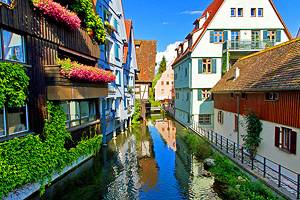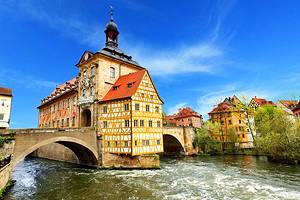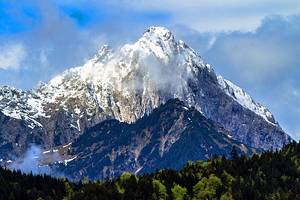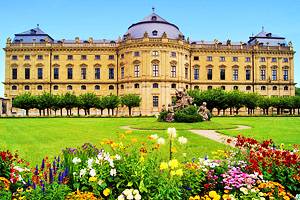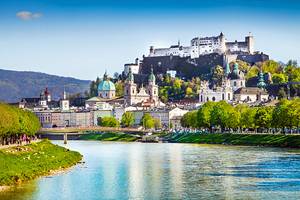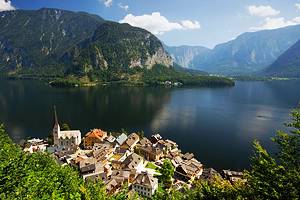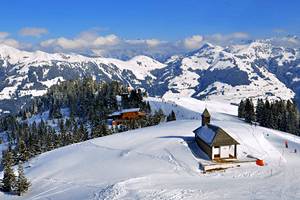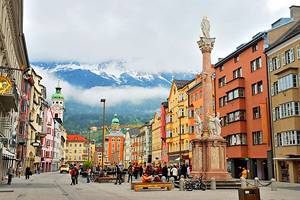Attractions & Things to Do in Bavaria
Bavaria, Germany's largest state, lies in the southeast corner of the country and is bordered by Austria and the Czech Republic. One of Germany's most popular tourist destinations, Bavaria is filled with attractions and things to do and offers some of the country's most beautiful scenery, including spectacular mountain peaks, rolling hills, and lovely lakes.
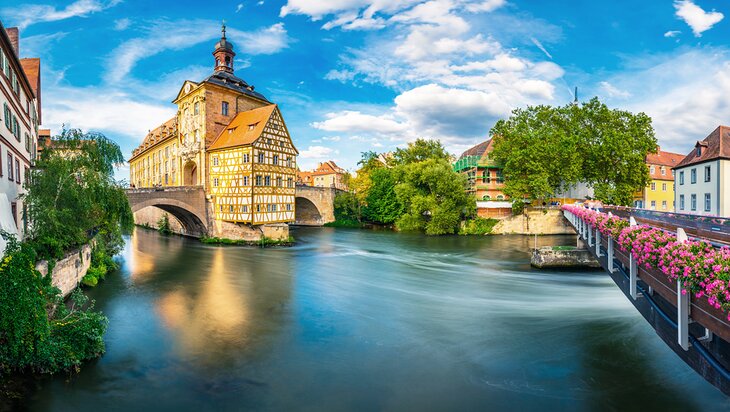
Alpine peaks mark Bavaria's southern border with Austria, and the Danube River winds scenically through its center. Sightseeing is not the only attraction of Germany's largest state: outdoor enthusiasts will find mountain trails to hike, riverside paths to cycle, and superb skiing. Some of the most beautiful towns in Germany are in Bavaria, and the entire area is steeped in history.
The Danube winds scenically through its center. Some of the most beautiful towns in Germany are in Bavaria, and the entire area is steeped in history.
Although Bavaria is one of the most traditional parts of Germany and is filled with romantic castles, grand imperial palaces, and endearing old-world customs, you'll find a lot more variety among its attractions, including a lively contemporary art scene, cutting-edge architecture and design, and state-of-the-art interactive museums.
You could easily spend an entire vacation here. Find the best places to visit with our list of the top attractions and things to do in Bavaria.
Neuschwanstein
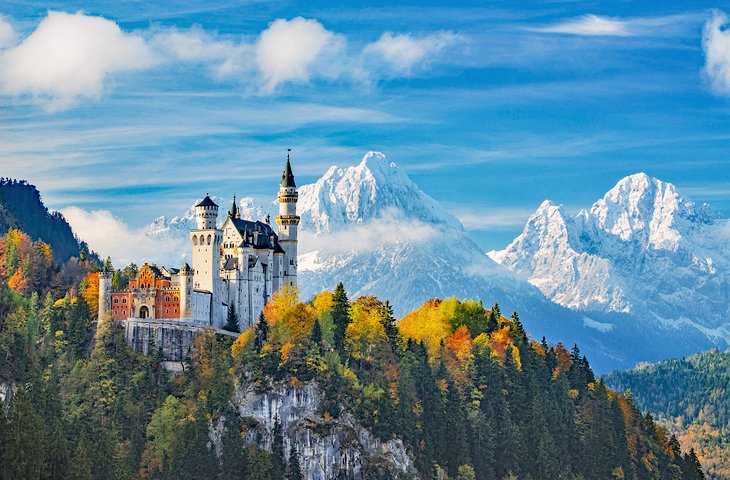
Perhaps "Mad" King Ludwig II was eccentric in his choice of a fairy-tale-inspired neo-Romanesque style for his castle, but his choice of setting was pure genius. The spires and towers rise from a rocky crag above a forest and lake, with a panorama of the Bavarian Alps rising beyond.
Widely recognized as the inspiration for Walt Disney's theme park castles, Schloss Neuschwanstein is every bit as fantastical inside as it is when first viewed from below. The Throne Room, the Singers' Hall, and other grandiose rooms are sumptuously decorated (some might say over-decorated) in themes drawn from heroic legends, opera, and romantic literature. The views of the Alps from the windows are simply breathtaking.
On a facing crag is another castle of the imperial Wittlebach family, Hohenschwangau. Not far away is the king's hunting lodge, Linderhof, an equally fanciful architectural confection.
Address: Neuschwansteinstraße 20, Schwangau
Watch the Glockenspiel in Marienplatz, Munich
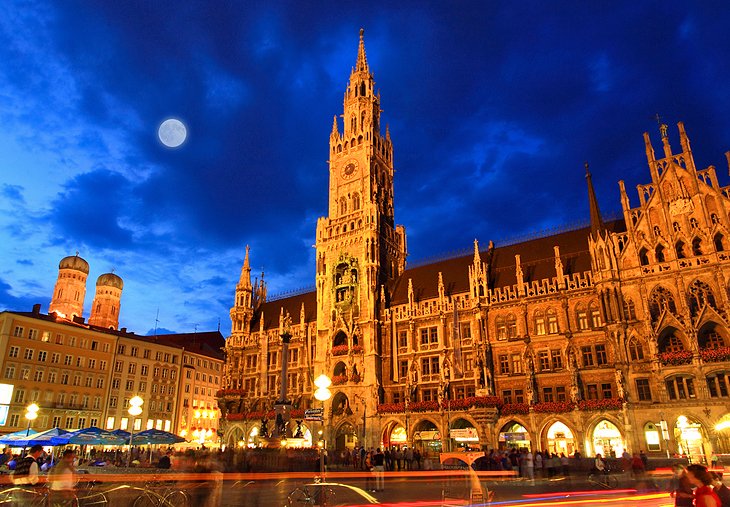
Munich, the capital of Bavaria, is the third largest city in the country and home to many of Germany's top tourist attractions. On the River Isar, along the fringes of the Bavarian Alps, it's one of the best places from which to explore Bavaria. A good place to start is Marienplatz, the city's large central square, one entire side of which is formed by the magnificent neo-Gothic facade of the Neues Rathaus (New Town Hall).
The glockenspiel, a huge clock animated with moving figures, performs every morning at 11am and at 5pm March through October, always drawing a crowd. One end of the immense square is formed by the stair-stepped façade of the Old Town Hall, and behind the other end of the square rises the distinctive twin-domed towers of the Frauenkirche, the Cathedral of our Lady.
A few steps from Marienplatz are two more of the city's most important churches: Peterskirche, built during the Romanesque period, and Michaelskirche, the largest Renaissance church north of the Alps. Marienplatz is the center for many of this always-busy city's cultural activities, from regular concerts and festivals to its fabulous Christmas Market.
Explore Zugspitze and the Bavarian Alps
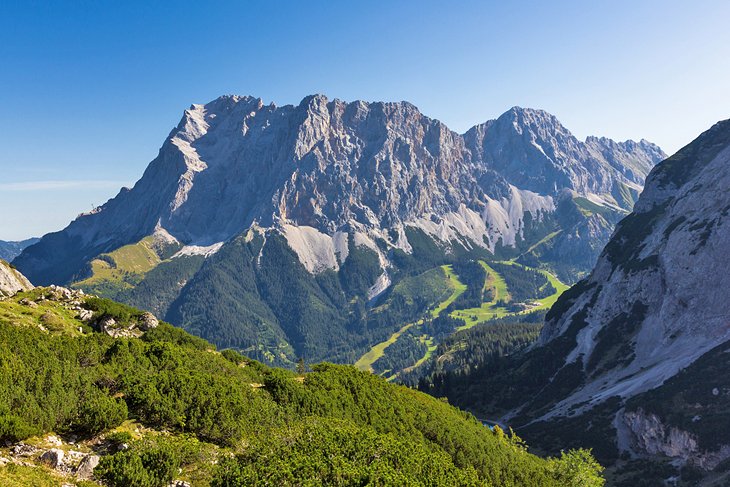
Bavaria's Zugspitze is part of the Wetterstein Alpine mountain range that spans the frontier between Austria and Germany. Surrounded by steep valleys, its 2,962-meter eastern summit is reached by cable car from Eibsee, or by the Bayerische Zugspitzbahn cog railway, a trip that begins in either Eibsee or in Garmisch-Partenkirchen. The cog train takes you to the Zugspitzplatt, from which a short cable car ride reaches the summit.
The mountain, Germany's tallest, is extremely popular among hikers and casual walkers alike, with numerous trails of all levels to choose from (those who want the views without the steep climb can ride up and walk down).
At the Zugspitz-Westgipfel Station is a panoramic restaurant at 2,950 meters. The nearby Schneefernerhaus on the northern edge of the Zugspitzplatt is a popular place for skiers to visit in the winter. The highest skiing area in Germany, it comes alive as winter sports enthusiasts from across Europe arrive for the superb snow and après ski activities.
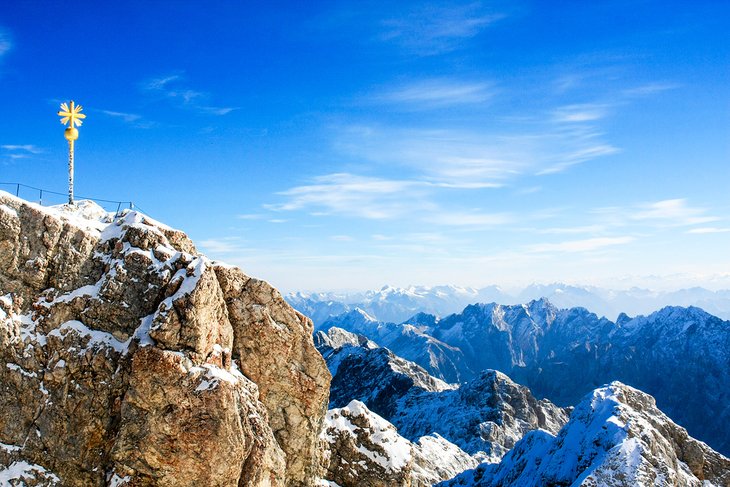
The Bavarian Alps extend south from Munich to the Austrian frontier and from beautiful Lake Constance in the west to the neighborhood of Salzburg in the east.
Reaching heights of almost 3,000 meters, their beauty enhanced by deep glacier-carved valleys and high plateaus with numerous lakes, the Bavarian Alps offer plenty of things to do. Along with winter sports, there are summer excursions of all kinds: forest walks, waterfalls, easy climbs, and gondola rides to spectacular views.
In the countryside, deep in its valleys, lie some of the most beautiful towns in Bavaria. Especially picturesque are the towns of Garmisch-Partenkirchen, Mittenwald, and Berchtesgaden, with their colorful painted houses and Baroque parish churches.
Nymphenburg and the Residenz, Munich's Royal Palaces
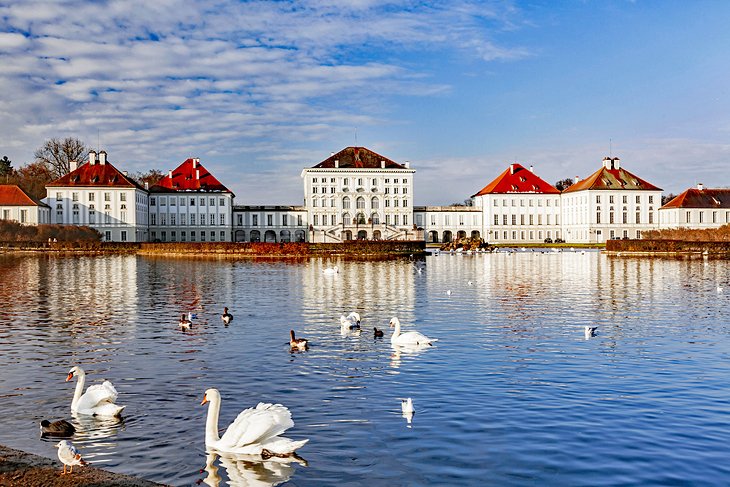
The Munich Residenz, the seat of the dukes, electors, and kings of Bavaria for centuries, is one of Europe's most spectacular palaces. In the summer, the royal family moved to their airy country palace of Nymphenburg, surrounded by magnificent gardens.
The vast in-town Residenz complex encloses seven large courtyards and has three main sections: the late Renaissance Alte Residenz; the Königsbau; and the Festsaalbau (Banqueting Hall), overlooking the Hofgarten. The magnificent 16th-century Antiquarium is now part of the Residenz Museum. Highlights to visit here include the Treasury, the Court Church of All Saints (Allerheiligen-Hofkirche), and Cuvilliés-Theater, along with the old courtyards and the beautiful Court Garden.
There's a much different atmosphere at the later Baroque palace of Nymphenburg, which seems to float above its canal, gardens, and fountain-splashed pools. In the 17th-century Central Pavilion, built in the style of an Italian villa, you'll find the lavishly decorated three-story Stone Hall (Steinerner Saal) and furnished private chambers.
In the outer buildings, you can visit the Palace Chapel and a collection of state coaches and carriages in the Marstallmuseum. For many, the highlights of Nymphenburg are its magnificent 17th-century gardens, with its formal bed, hedge maze, Palm House, and fountains, and the Amalienburg, a grand hunting lodge featuring a Hall of Mirrors.
Tour Nürnberg Castle and Altstadt (Old Town)
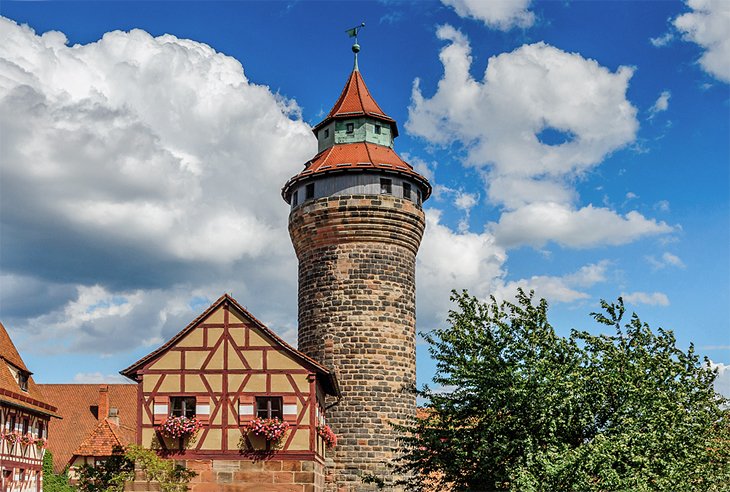
Although badly damaged in World War II, Nürnberg's historic Altstadt has been painstakingly restored to its prewar condition. Enclosed by more than four kilometers of walls that date from the 12th to the 16th century, the Old Town is dominated by Nuremberg Castle, a 351-meter-tall fortification that's among the most important surviving medieval fortresses in Europe.
Home of German kings and emperors for more than 500 years, Nürnberger Burg contains several historic structures to visit: the 15th-century imperial stables, the Pentagonal Tower dating from 1040, the 11th-century Kaiserburg, a 13th-century chapel, the Well House, and the Sinwell Tower with panoramic views over the steep gabled rooftops of the Old Town. The Imperial Castle Museum displays medieval weapons and armor.
Just beneath the castle is the half-timbered Albrecht Dürer House, a museum dedicated to the artist and his work. Other highlights of the Old Town are the Hauptmarkt, site of Nuremberg's famous Christmas Market (Nürnberg Christkindlesmarkt) and the 14th-century Gothic church of St. Lawrence (St. Lorenz, or Lorenzkirche), with its nine-meter rose window.
Address: Auf der Burg 13, Nürnberg
Relax in the Englischer Garten (English Garden), Munich
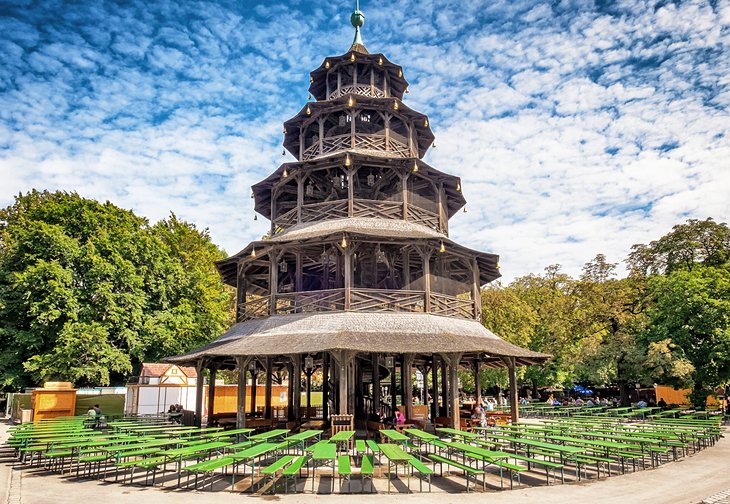
One of the most popular places to go in Munich, for both locals and tourists, the English Garden attracts walkers, joggers, and cyclists with 78 kilometers of pathways and bridle paths, and sunbathers with acres of lawn and riverbanks. A good place to visit for families, the gardens have playgrounds and plenty of places to run.
The Chinesischen Turm (Chinese Tower), a 25-meter-tall pagoda, has a café and is always a hub of activity - especially in December when it hosts one of the city's several Christmas markets.
The park's newest feature is the Japanese Garden, on an island of its own, complete with an authentic teahouse presented to the city in honor of the 1772 Olympics. The park also contains the Bavarian National Museum, with medieval German sculptures and tapestries, and the Bavarian State Archaeological Collection of local prehistoric artifacts.
Rothenburg and the Romantic Road
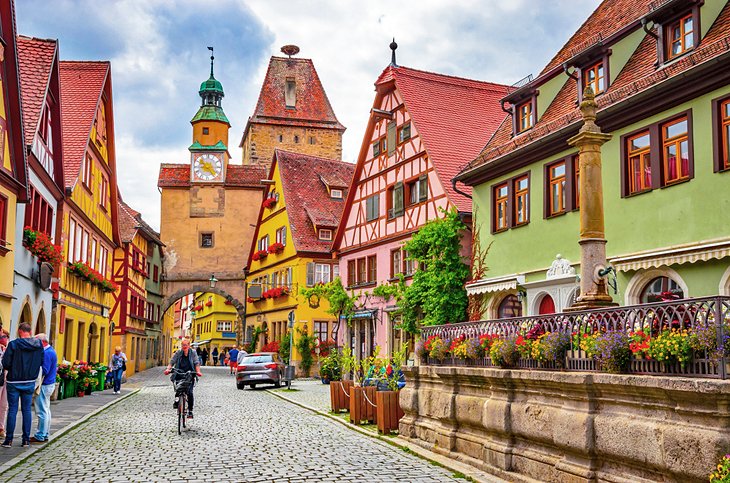
The three medieval walled towns of Rothenburg-ob-der-Tauber, Dinkelsbühl, and Nördlingen are highlights of the Romantic Road, a driving route that scenically through the rolling countryside of Bavaria and northern Baden-Württemberg. Rothenburg is one of the best-preserved medieval towns anywhere in Europe, its postcard-perfect streets lined by half-timbered houses, and its shops and cafes marked by intricately crafted wrought-iron signs.
Walls enclose the Old Town and seem to hold it from tumbling down into the Tauber River below. It's December all year-round at the town's most famous shop, Käthe Wohlfahrt's Christmas Village, just off the Market Square.
Dinkelsbühl owes its prosperity to the wool trade of the 15th and 16th centuries, when the row of gabled houses on the Weinmarkt was constructed. Look especially for the ornate wooden trim on the Deutsches Haus and for the 16th-century patrician Hezelhof.
Visit Linderhof Palace
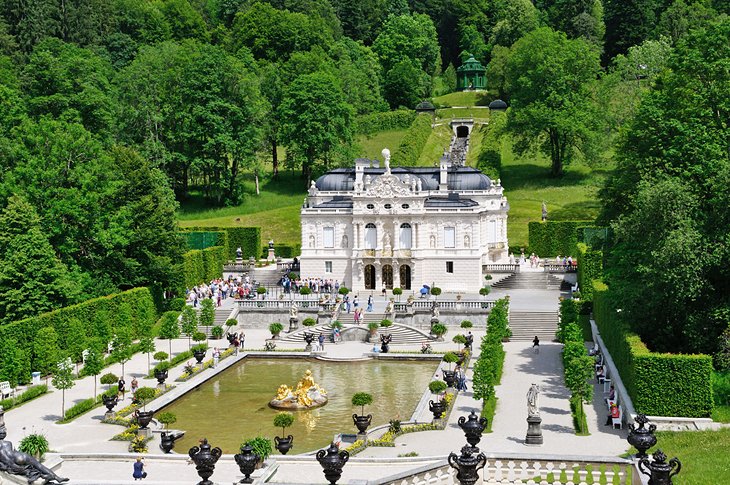
Linderhof Palace was King Ludwig II's favorite, and it's easy to see why. Although it glitters with lavish ornamentation, its size and its setting amid cool green forests give it an intimate and livable quality. On a tour, you'll see the Hall of Mirrors, the Audience Chamber that Ludwig used as a study, the two tapestry Chambers, the King's Bedchamber, and the Dining Room. On the required guided tour, you'll hear stories about this eccentric king.
A tour is also required for the Venus Grotto, Ludwig's fantastic man-made cavern, but you can explore the lovely gardens and grounds on your own, where you'll find both landscape and formal gardens, fountains and pools, and the Moorish Pavilion.
Address: Linderhof 12, Ettal
Königssee and Kehlsteinhaus (Eagle's Nest)
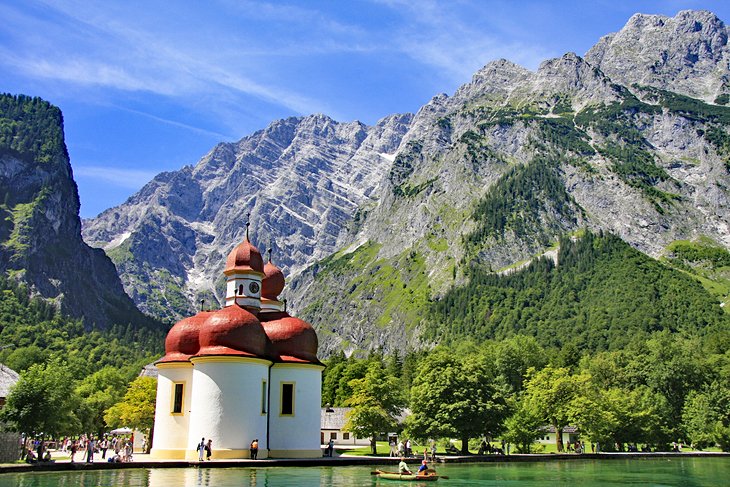
One of the most beautiful spots in Bavaria is the emerald green Königssee, a lake surrounded by steep wooded mountainsides and the rocky cliffs of the Watzmann range. On its shore, the distinctive red domes of the little pilgrimage church of St. Bartholomew reflect in its clear waters. The church dates to 1697, and inside is beautiful stucco work. You can reach it by boat from Schönau, and a footpath leads along the east shore of the lake for superb views of the church and lake from the Malerwinkel.
Nearby Berchtesgaden is one of the most popular resort towns in the Bavarian Alps, surrounded by mountains — the Hoher Göll, Watzmann, Hochkalter, and Untersberg. You can't drive the 6.5-kilometer-long Kehlsteinstrasse, the steep road to the infamous symbol of power of the Nazi regime known as the Eagle's Nest.
Instead, you can ride the gleaming brass elevator through the mountain; like the mountaintop Kehlsteinhaus itself, it was built to impress. In fact, Hitler was rarely there, and today it has only a few original features, but it's still a grim reminder of the horrors of that era of unbridled power. Inside is a restaurant with panoramic views of the Alps.
Dachau Concentration Camp Memorial
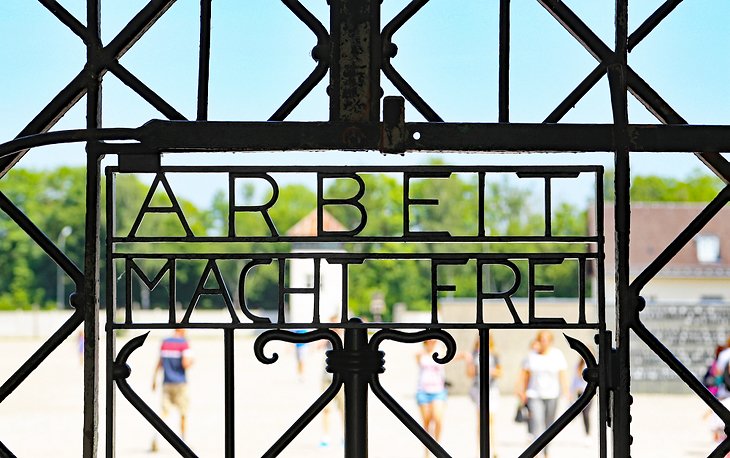
Before World War II and the Nazi era, the little town of Dachau was known for its castle and as a plein air artists' colony. Today, the attractive town's name is almost synonymous with the Holocaust, as the site of the notorious Dachau concentration camp, where 41,000 people died during the Nazi regime.
The KZ-Gedenkstätte Dachau is now a somber memorial to those victims and to countless others like them. Barracks and cells have been reconstructed, and the stories of its prisoners are told through photographs, personal accounts, artifacts, and documents. Guided tours in English are offered daily.
Address: Pater-Roth-Str. 2a, Dachau
Take a Boat to Herrenchiemsee
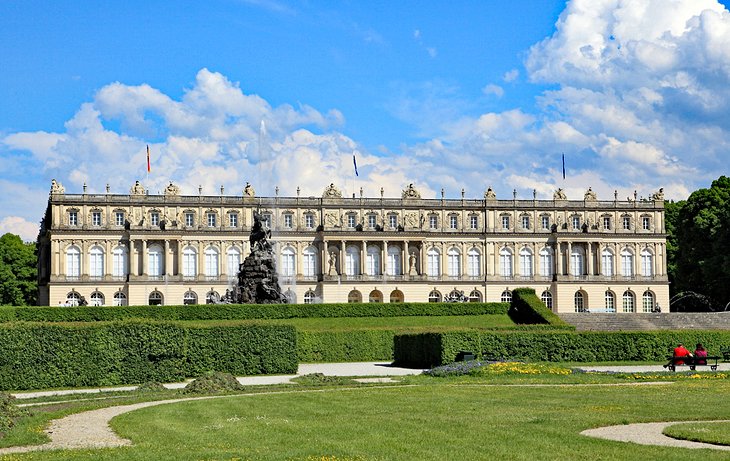
King Ludwig II of Bavaria chose an island in Chiemsee, Bavaria's largest lake, as the site of his third and largest palace, Herrenchiemsee. He envisioned it as a rival to Versailles in its grandeur and splendor, even to the Hall of Mirrors, but it was only partially completed when he was drowned near Neuschwanstein, at the age of 40.
Much of the palace had been completed as he envisioned it, including the Hall of Mirrors; State Staircase; State Bedroom; and Ludwig's Small Apartment, decorated sumptuously in the Rococo style. The King Ludwig II Museum displays artifacts and furnishings connected to his life, and the surrounding gardens, also patterned after Versailles, are decorated with fountains and statues. You can reach the island by boat from Prien or Stock. Guided tours of the palace, the only way you can see it, are available in English.
On the smaller Frauenchiemsee island is a monastery founded in the 8th century and extended in the 12th and 13th centuries. Parts of the original remain, and the present church dates at least from the 11th century. That island is the scene of a charming Christmas market each December, featuring fine handmade gifts and decorations.
Imperial Regensburg
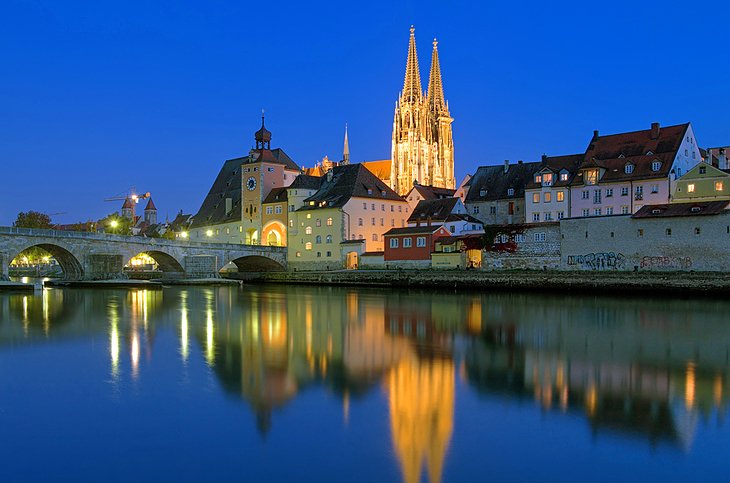
The old imperial city of Regensburg lies at the most northerly point of the Danube, joined here by the River Regen and navigable all the way to the Black Sea. The town's medieval Old Town, made up of churches and aristocratic homes from the 13th and 14th centuries, is a UNESCO World Heritage Site. Crossing the Danube, the 310-meter-long Stone Bridge, was built in the 12th century and is a masterpiece of medieval engineering,
The 13th-century Cathedral of St. Peter in Domplatz, the city's central square, is considered to be the finest Gothic church in Bavaria, with a magnificent west front and delicate twin spires marking the city's skyline at 105 meters high. Highlights of the interior are the superb 14th-century stained glass and the figures of the Annunciation from 1280.
Romanesque All Saints Chapel, off the beautiful 14th-century cloister, features wall paintings, and St. Stephen's Chapel predates the cathedral, dating back to AD 800. The cathedral is known for its boys' choir, the Domspatzen, one of Europe's finest.
Bamberg Cathedral
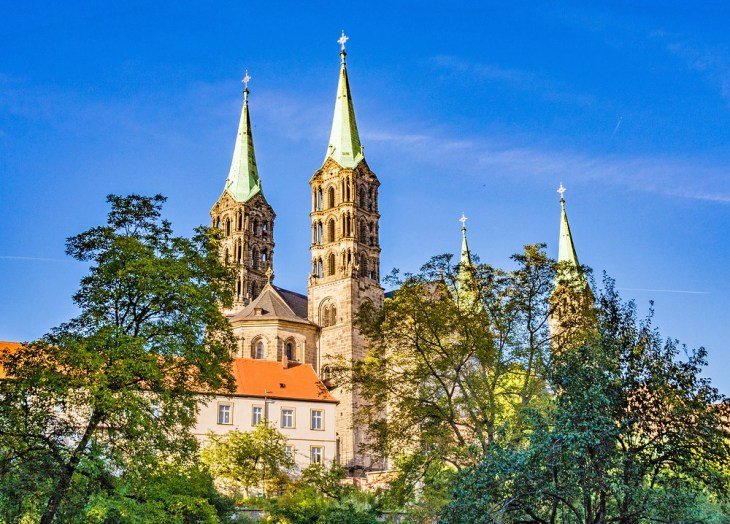
Bamberg Cathedral — affectionately referred to by locals as Domberg — lies high atop a hill overlooking one of Bavaria's most picturesque small cities. This four-towered masterpiece of early 13th-century ecclesiastical architecture includes the Fürstentor (Prince's Doorway), with its figures of apostles and prophets, and a relief of the Last Judgment.
Be sure to see the Adamspforte (Adam's Doorway) along with the Marienpforte (Virgin's Doorway). Inside is the tomb of Henry II, who died in 1024, along with that of his wife Kunigunde.
The cathedral's best-known feature is the famous Bamberger Reiter, or the Bamberg Horseman, erected in 1240. The identity of the figure pictured is something of a mystery. Various theories include Emperor Henry II; King Stephen of Hungary (Henry II's brother-in-law); and Holy Roman Emperor Frederick II, a major patron in rebuilding the cathedral. The Diocesan Museum displays the cathedral treasury with vestments and Henry II's imperial robes.
Other places to visit in Bamberg's Old Town are the Altes Rathaus (Old City Hall), which now houses a porcelain museum, and the Altenburg, a 12th-century castle crowning the tallest of the city's seven hills.
Address: Domplatz 5, Bamberg
Hike through the Partnach Gorge
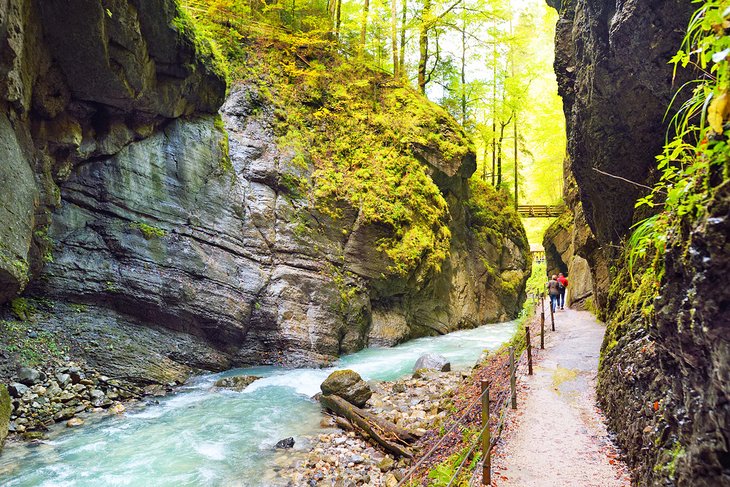
One of Bavaria's most dramatic natural wonders, the Partnach Gorge is a narrow crevasse cut into the solid rock by the Partnach River in Garmisch-Partenkirchen. Its formation began millions of years ago, and over the millennia meltwater and the debris from the Schneeferner Glacier on the Zugspitz plateau, carried by the rushing river, scoured the gorge to its current depth of 263 feet (80 meters).
Two trails, one of them right along the river's edge, take you beneath the vertical rock walls, past waterfalls, cascades, rushing rapids, and pools. The lower trail is the easiest; the upper one goes through tunnels less than six feet in height as it traverses the 699-meter (2,293-foot) gorge.
Those with a head for heights can climb the steep steps to view the gorge from the iron suspension bridge, which spans the forested summit 70 meters (225 feet) above the river. You can also take a torchlight tour of the gorge at night.
The gorge is open year-round, and is spectacular in the winter, when the walls become giant curtains of icicles. The Partnach Gorge is also the gateway to several hiking trails. To get to the gorge, follow the signs from the Olympic Stadium in Garmisch-Partenkirchen; it is a 25-minute walk.
Read More: Hikes in Europe
Passau and the Danube
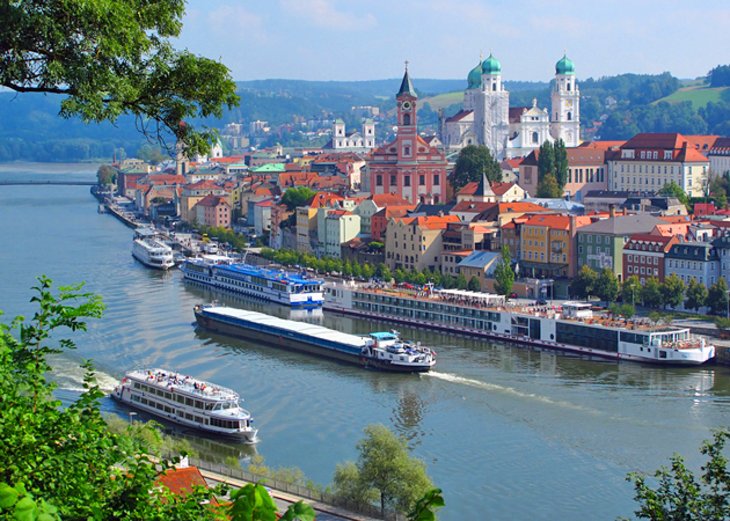
Passau lies on the Austrian frontier at the junction of the Danube and the River Inn and is famous for its flat-roofed, 17th-century, Italian-style houses linked by flying buttresses. Other highlights of the Old Town, widely regarded as one of the most picture-perfect townscapes in Europe, include the Oberhaus fortress, the Mariahilf church, and the charming stepped lanes leading down to the two rivers.
In the Domplatz, surrounded by old canons' houses, stands the Cathedral of St. Stephen, known for its massive organ, the largest church organ in Europe and the second largest in the world. The cathedral's Late Gothic east end dates from 1407 and the superb Baroque nave was added in 1678. Also of interest is Residenzplatz, with its old homes, and the New Bishop's Palace (Neue Residenz) built in 1772, home to the Cathedral Treasury and the Diocesan Museum.
The most fascinating museum, especially for visitors who admire fine glasswork or Jugendstil (Art Nouveau) design, is the Glasmuseum Passau, which displays the world's largest collection of Bohemian glass. The collection, which represents work from 1650 to 1950, features more than 1,000 Loetz pieces, including those shown at the 1900 Paris Exposition.
Passau is the starting point for Danube River cruises, both short day excursions and longer trips to Vienna, Budapest, and the Black Sea.
Art Museums in Munich's Kunstareal District
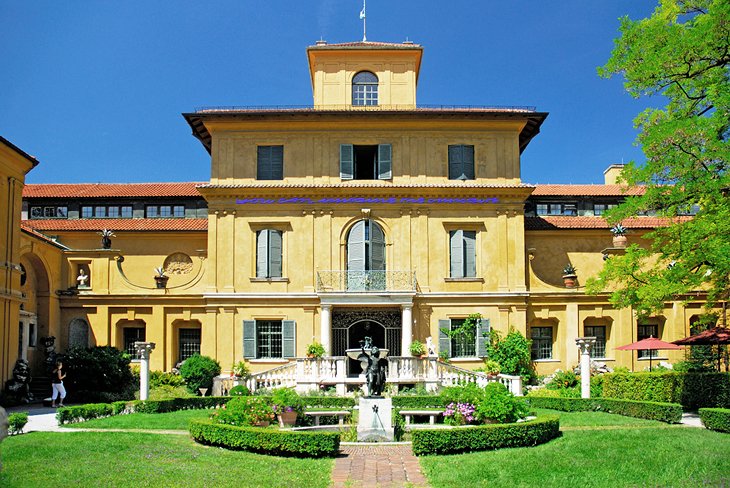
The art district around the Neoclassical Königsplatz features one of the finest groups of art museums anywhere in Europe. The three Pinakothek art galleries cover Europe's major art movements and styles. In the Old Picture Gallery (Alte Pinakothek) are the Dutch and Flemish masters and outstanding Italian, German, French, Spanish, and medieval paintings.
The New Picture Gallery (Neue Pinakothek), picks up with works ranging from the Rococo to Art Nouveau periods (note that this building is currently undergoing a major renovation, and highlights of its collections are temporarily exhibited in galleries on the ground floor of the Alte Pinakothek).
The State Gallery of Modern Art (Pinakothek der Moderne) houses an exceptional collection of more than 20,000 works after 1900 covering the Bauhaus, Cubism, Futurism, the Fauves, and other important avant-garde movements, with works by Picasso, Warhol, Magritte, and Dalí. The Glyptothek and the State Antiquities Collection (Staatliche Antikensammlung) reach further back into ancient sculptures and classical art.
The sixth and newest of this remarkable ensemble of art museums is Lenbachhaus, the Italianate villa of artist Franz von Lenbach, which, with its new extension, houses the world's finest collection of works by the Blauer Reiter (Blue Rider), a group of European Expressionist painters led by Wassily Kandinsky and Franz Marc.
Address: Königsplatz, München
Cruise through the Danube Gorge from Weltenburg Abbey
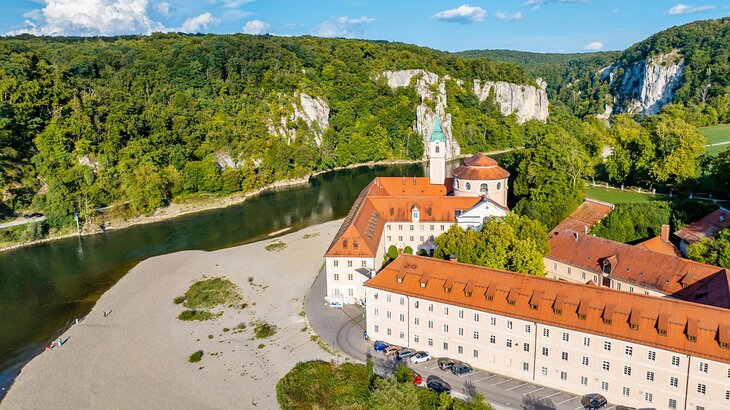
Carved about 200,000 years ago when a branch of the Danube wore through the limestone and changed the course of the river, the Danube Gorge is a five-kilometer ravine with rock walls as high as 70 meters.
One of the most beautiful spots along the Danube, the gorge is best experienced on a cruise. You can board a boat (be sure you get one with a return sailing) from the dock at Weltenburg Abbey. This formidable monastery sits beside a deep bend in the Danube and is believed to be the oldest in Europe, dating back to 620.
Be sure to see the Baroque abbey church, built and decorated by brothers Cosmas and Egid Asam, who were to later build the famous Rococo Asamkirche in Munich. Its architecture and decorative stucco work and frescoes make it one of the most important works of Baroque art in Europe.
You can take a 30-minute tour of the abbey and church, and be sure to stop for a slice of the Abbey's Asam layer cake at the open-air café. For spectacular views of the Abbey and Danube Gorge, you can hike along the top of the gorge.
Map of Attractions & Things to Do in Bavaria
More Related Articles on PlanetWare.com
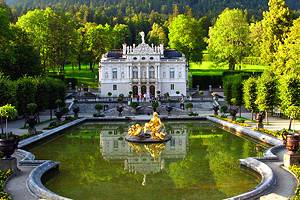
Discovering More of Bavaria: After seeing the highlights of Bavaria, you may want to see more of the top tourist attractions in Munich and explore its best museums and art galleries. You'll find more nearby places to visit with the help of our pages on the top day trips from Munich and the top attractions of Nuremberg (Nürnberg).
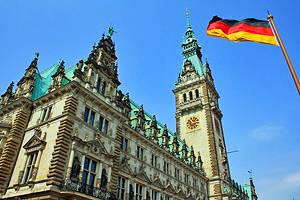
Exploring Germany: For a good overview of the country's best experiences, see our page on the tourist attractions in Germany. To discover more of the north, you might travel to the exciting capital city of Berlin and explore the historic port of Hamburg.



